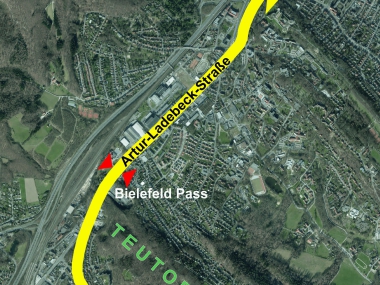"5 Guidelines" - cycling promotion in Bielefeld in general
Edited on
13 March 2018As a long-time member of the "Working Group for Cycling-Friendly Cities, Districts and Municipalities in North Rhine-Westphalia" (AGFS NRW), cycling promotion is playing an important role in all transport planning in Bielefeld. Nevertheless, there are potentials in cycling that have not yet been fully exploited: after all, almost 50% of all journeys by car are shorter than 5.0 km and therefore actually the ideal cycling distance. An increase in the share of cycle traffic in the total traffic volume, which currently stands at 18%, is thus feasible, but requires a consistent cooperation of planners and decision-makers.
As a basis for this, the city council decided in June 2016 on five guiding principles that were formulated because of the "Bicycle Police Audit" (BYPAD) by the transport policy relevant groups:
- Increasing the share of cycling to 25% by 2025
- Development of a bicycle traffic concept
- Develop and strengthen infrastructure
- Expand service / communication / public relations
- Create work structures

"Chip pass - Or how to get over Teutoburger Forest Hill by bicycle" - cycling promotion in particular
In this context, the call of the Federal Environment Ministry for the "Federal Competition for Climate Protection in Cycling" at the end of 2016 was just the right time to concretize and fill the goals with life. With the announcement of the "Sponsorship competition for exemplary investment projects for climate protection by strengthening bicycle traffic", the planners of Bielefeld’s Transport Department applied with „Steilpass- (translates in English to Chip pass) - Or how to get over Teutoburger Forest Hill by bicycle". The aim is to improve the cycling situation between the south of Bielefeld and the city centre at a topographically favourable location, thus making a contribution to cycling promotion and thus to climate protection.
The planning task will focus on the Artur-Ladebeck-Straße, an important inner-city main thoroughfare. It crosses the Teutoburg Forest Hill at its lowest point in the Bielefeld urban area, at the so-called "Bielefeld Pass". The street has developed over the years to an accident accumulation route for cycling. Single measures could not sustainably increase traffic safety. A transformation on the whole length, so far was not feasible due to lack of financial resources.
A functional improvement and coordination of this important cycle traffic axis between the south of Bielefeld and the centre to the needs of everyday cyclists will be a benefit, both the district-spanning as well as the district-based cycling benefits. Increasing safety, comfort and performance on wheeled traffic systems play a key role here. Overcoming topographical hurdles and longer distances will become increasingly easier by increasing "electrification" in cycling. This foreseeable development should be considered as early as possible by creating secure and high-performance infrastructure offerings.
The planning is being worked out in close collaboration with the relevant stakeholders and the public as well as neighbouring business. The amount of 3.200.000 € will be available from the subsidy fund for the implementation of the measure.
Submitted by Olaf Lewald on
